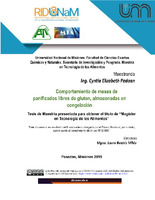| dc.rights.license | Licencia de Creative Commons Reconocimiento-NoComercial-CompartirIgual 4.0 Internacional (CC BY-NC-SA 4.0) | |
| dc.contributor | Milde, Laura Beatriz | |
| dc.creator | Padoan, Cyntia Elizabeth | |
| dc.date.accessioned | 2022-05-08T15:00:10Z | |
| dc.date.available | 2022-05-08T15:00:10Z | |
| dc.date.issued | 2019-10-03 | |
| dc.identifier.citation | Universidad Nacional de Misiones. Facultad de Ciencias Exactas, Química y Naturales. Secretaría de Investigación y Posgrado. Maestría en Tecnología de los Alimentos (2019). Comportamiento de masas de panificados libres de gluten, almacenadas en congelación (Tesis de Maestría) / Directora, Mgter. Laura Beatriz Milde; Maestranda, Lic. Cyntia Elizabeth Padoan; Posadas (Misiones): UNaM. FCEQyN. SIyP. MTA. 61 p. | es_AR |
| dc.identifier.other | TM-009 | |
| dc.identifier.uri | https://hdl.handle.net/20.500.12219/3053 | |
| dc.description | Fil: Padoan, Cyntia Elizabeth. Universidad Nacional de Misiones. Facultad de Ciencias Exactas, Químicas y Naturales. Secretaría de Investigación y Posgrado. Maestría en Tecnología de los Alimentos; Argentina. | es_AR |
| dc.description.abstract | En la presente tesis se trabajó con una formulación de pan libre de gluten, utilizando fécula de mandioca-harina de maíz en proporción 4:1, azúcar, harina de soja, sal, huevo, grasa vegetal y agua; se utilizó levadura deshidratada.
El objetivo fue analizar el efecto del levado de las masas con tratamientos pre y post almacenamiento congelado, por determinación de parámetros físicos (volumen específico y porcentaje de pérdida de peso), texturales (firmeza y elasticidad) y análisis sensorial del producto final cocido. Las masas fueron almacenadas congeladas (-20 oC) por 28 días, en moldes individuales; descongeladas a los 7, 14, 21 y 28 días y analizadas como panes. Se utilizó un pan elaborado en el día como control (fresco). Se realizó análisis sensorial descriptivo para ambos tratamientos evaluando los atributos: apariencia de la miga, dureza, masticabilidad y sabor.
Los panes obtenidos fueron afectados en su calidad por el almacenamiento congelado. Los parámetros físicos evaluados mostraron menor daño con el tratamiento de levado pre almacenamiento congelado. El mismo resultado se obtuvo con el parámetro firmeza a partir del día 7 de almacenamiento congelado; mientras que la elasticidad no presentó diferencias significativas durante el tiempo de almacenamiento congelado en ambos tratamientos. En cambio, en la evaluación de los atributos sensoriales, apariencia de la miga y sabor, con el tratamiento de levado post almacenamiento congelado, se obtuvieron respuestas más favorables a los diferentes días.
Teniendo en cuenta que la evaluación sensorial se utiliza en el control de calidad
de los productos alimenticios, y determina su aceptación, se optaría por el levado post almacenamiento congelado para extender la vida útil de la formulación estudiada. | es_AR |
| dc.description.abstract | In this Thesis a formulation of gluten free bread, cassava starch and corn flour (4:1) and ingredients such as sugar, soybean flour, salt, egg, vegetable fat and water; dry yeast was used. The aim of this work was to analyze the effect to ferment treatments of the dough pre and post frozen storage, by determining the physical parameters (specific volume and weight loss percentage), textural parameters (firmness and elasticity) and sensory analysis of the final cooked product. The doughs were stored frozen (-20 oC) for 28 days, in individual molds; thawed at 7, 14, 21 and 28 days and analyzed as loaves.
An elaborated bread during the day was used as control (fresh). A descriptive sensory analysis was carried out for both treatments, evaluating the attributes: appearance of the crumb, hardness, chewiness and taste. The loaves obtained were affected in their quality by frozen storage. The physical parameters evaluated showed less damage with the ferment treatment of the dough before frozen storage The same result was obtained with the firmness parameter from day 7 of frozen storage; while the elasticity did not present significant differences during the frozen storage time in both treatments.
On the other hand, in the sensory attributes evaluation, appearance of the crumb
and flavor, with the ferment treatment of the dough after frozen storage, more favorable responses were obtained to the different days. Taking into account that the sensory evaluation is used in the quality control of food products, and determines its acceptance, we would choose the fermented of the dough after frozen storage to extend the useful life of the formulation studied. | |
| dc.format | application/pdf | |
| dc.language.iso | spa | es_AR |
| dc.publisher | Universidad Nacional de Misiones. Facultad de Ciencias Exactas, Química y Naturales. Secretaría de Investigación y Posgrado. Maestría en Tecnología de los Alimentos | es_AR |
| dc.rights | info:eu-repo/semantics/openAccess | |
| dc.subject | Masa congelada | es_AR |
| dc.subject | Sin gluten | es_AR |
| dc.subject | Tratamiento de levado | es_AR |
| dc.subject | Levadura deshidratada | es_AR |
| dc.subject | Frozen dough | es_AR |
| dc.subject | Gluten free | es_AR |
| dc.subject | Fermented treatment | es_AR |
| dc.subject | Dry yeast | es_AR |
| dc.title | Comportamiento de masas de panificados libres de gluten, almacenadas en congelación | es_AR |
| dc.type | info:eu-repo/semantics/masterThesis | es_AR |
| dc.type | info:ar-repo/semantics/tesis de maestría | |
| dc.type | info:eu-repo/semantics/acceptedVersion | |



